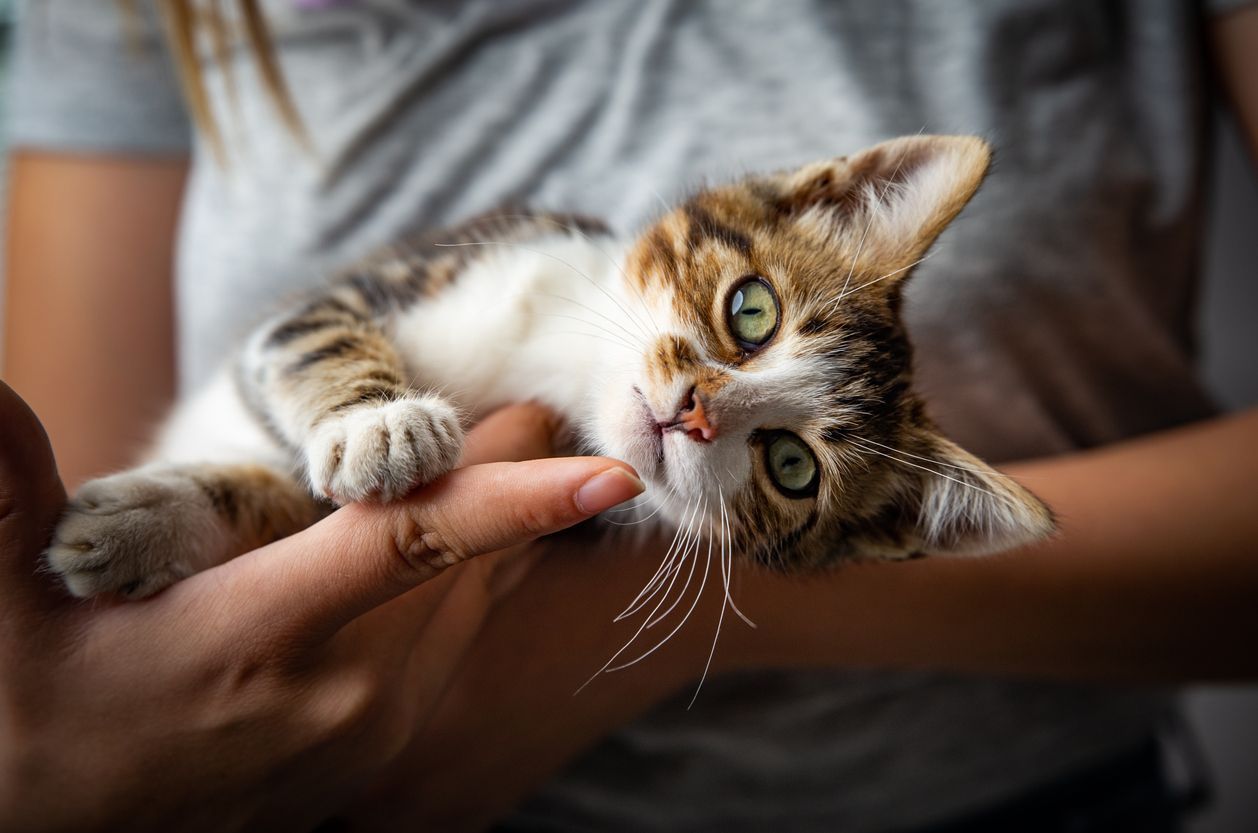Cat health checklist: What is your cat’s normal?

Cats show signs of illness and discomfort differently than people, and issues can go unnoticed by cat owners if they don’t know what to look for. It’s important for pet owners to know their cat’s normal vital signs and behavior in order to catch if something is wrong early. Read on if you have ever asked:
- What are the normal signs of physical health in cats?
- Is my cat behaving normally?
- What are the signs of illness in my cat?
- How will my sick cat be treated by a veterinarian?
- How can I help my cat stay healthy?
While there are normal ranges in vital signs that veterinarians look for, every cat is different. Your cat’s normal may be slightly outside of these ranges. However, it’s important to know what your cat’s normal is in order to catch any illnesses early.
What are the normal vital signs of a cat?
TPR stands for temperature, pulse or heart rate, and respiration. These vital signs are documented during veterinary visits with a physical examination. Changes in normal vital signs often tell us when something is wrong with our pets. It’s important for pet owners to know what their cat’s normal vital signs are and how to check vital signs. Each individual cat’s normal vitals vary, so it’s important to know your cat’s baseline for reference if you suspect they might be out of range.
Temperature
A cat’s normal body temperature ranges from 100°F (37.8°C) to 102.5°F (39.1°C). A rectal temperature is the only way to accurately measure a cat’s temperature, and a digital thermometer is the fastest method. A digital thermometer may also be easier to read accurately. Taking a cat’s temperature isn’t always easy, especially if they are feeling unwell. Only attempt to take your cat’s temperature if it can be done safely. A virtual vet appointment is a great way to learn how to accurately and safely check your cat’s temperature from home.
Pulse/heart rate
The normal feline heart rate is between 140 to 200 beats per minute (BPM) at rest. To calculate your cat’s heart rate, cup your hand around your cat’s chest just behind the armpits and apply gentle pressure until you can feel a regular rhythm. Count the beats for 15 seconds and multiply by four. A healthy cat’s pulse is regular without skips or extra beats. Your cat’s heart rate may be slightly outside of this range and still healthy, especially if they have recently exercised.
Respiratory rate
At rest, a cat’s respiratory rate is about 15 to 30 breaths per minute. Watch for the rise and fall of their breath on their chest or back or feel for their breath lightly with your hand. Count the breaths for 15 seconds and multiply by four. A healthy cat breathes easily with no panting, coughing, raspiness, or distress.
Other physical signs
In addition to normal vitals, these are other signs of feline good health that can be checked routinely at home:
- Body condition score: Ribs and spine easily felt but not seen, belly and waist tucked
- Eyes: Bright and clear, no discharge or discoloration
- Ears: Alert, clean, and clear with no discharge or foul odor
- Nose: Moist and clean with no discharge or cracked skin
- Mouth: Teeth clean and intact, no bad breath or tartar buildup
- Gums: Pink and moist, no inflammation, redness, bleeding, or sores
- Capillary refill time: Less than two seconds. Press into the pink part of gums to check the return of color
- Hydration status: Pinch up a fold of skin at the back of the head, then release it. The skin should bounce back quickly with no tenting
- Mobility: Walking, running, and jumping with no limping or favoring either side
- Coat: Coat smooth and shiny, skin clean and clear underneath
What is healthy cat behavior?
Every cat has their own normal behavior and individual personality. Factors such as age, size, past experiences, and overall energy levels vary between cats and affect what is considered normal. Some cats are naturally aloof or even fearful, but many pet cats are playful and enjoy being around their owners. Showing interest in playing with toys, climbing structures, scratching posts, their owners, and other cats within their household is also an indicator of good health. In addition, healthy cats:
- Eat and drink normally
- Have regular urination and pass stools with no diarrhea or straining
- Groom themselves easily
- Move around normally with no limping or lack of coordination
- Appear comfortable
- Show no sudden behavioral changes like unusual signs of aggression
- Sleep often throughout the day and night
Every pet cat is different, but these are general characteristics of healthy cats. Levels of playfulness and socializing varies between cats as well. However, changes in normal individual behavior can be an indicator that something is wrong.
What are the signs of illness in a cat?
The first signs that a cat is ill or injured can be subtle. “Cats tend to hide pain or exhibit it in ways that differ from humans,” says Dr. Jo Myers, a veterinarian with Vetster. “Knowing your cat’s physical and behavioral ‘normal’ is crucial to help catch warning signs early.” Changes in TPR such as increased or decreased temperature, pulse rate, or respiration rate could indicate illness in a cat. Other physical changes to look out for during an examination include tenting in the skin, change in gum color, slow capillary refill time, changes in breathing sounds, or difficulty breathing.
Behavioral changes may also point to an injury or illness. Signs of lethargy, changes in eating and drinking habits, painful or difficult mobility, unexplained weight loss or weight gain, or vomiting, diarrhea, coughing, or sneezing are signs to contact your veterinarian. This list is not exhaustive, so contact a vet if your cat shows any sudden changes in their physical or behavioral health.
How are sick cats treated by a veterinarian?
Before a treatment plan can be developed, a veterinarian needs to know what is wrong. If you bring your cat into the clinic for assessment, they will need a thorough physical examination of their entire body as well as diagnostic testing. Depending on what is found on examination, testing may include X-rays, bloodwork, fecal examination, urine tests, or other testing to pinpoint your cat’s diagnosis. Once the diagnosis is made, treatment can be targeted against the specific condition. Vets use a variety of therapeutic approaches for sick cats, the same as doctors do for people. A sick cat may be sent home with medications and instructions for nursing care or kept in the hospital for more aggressive treatment.
How can I keep my cat healthy?
Keeping your feline friend healthy starts with a healthy diet, clean water, and access to exercise at home. Cats also require mental stimulation through toys, climbing perches, scratching posts, and places to hide throughout your home. Place their litter box, food, and water bowls in low-traffic areas to help them feel safe. Regular grooming can help keep the skin and coat healthy, especially for long-haired cats.
In addition, visit the vet for annual checkups and ensure your cat’s vaccines and parasite prevention is up to date. By visiting your vet regularly instead of only when a problem arises, you may be able to catch illness early, resulting in a better outcome and more affordable treatment. If you are concerned about whether your cat’s physical or behavioral signs are normal, you can chat with an online vet from home.
FAQ - Cat health checklist: What is your cat’s normal?
What are some of the most common medical conditions in cats?
Dental disease and obesity are very common in pet cats, but there are steps you can take at home to prevent them. Both dental disease and obesity can lead to other serious health complications, so complying with your vet’s recommendations can keep your cat’s dental health and body condition on track.
How do I know if my cat is happy?
If your cat is exhibiting healthy behaviors at home, such as playing, climbing, and socializing with you and their housemates, your cat is likely happy and has a good quality of life. Sudden changes in these behaviors can be an indicator of stress, injury, or illness.
What are the signs of a sick cat?
Changes in normal physical condition or behavior can indicate something is wrong. It is important to know and routinely check your cat’s normal physical health and note any changes in symptoms, energy level, or other physical or behavioral norms to catch signs of illness early.
How do you check a cat’s vital signs?
A cat’s temperature is checked rectally with a lubricated rectal thermometer. Taking a cat’s temperature at home is not easy, so only attempt if you are comfortable with the process and can do so safely. Your cat’s pulse can be felt on the chest or inside the thigh. Breathing can be observed by watching their chest and sides rise and fall.




